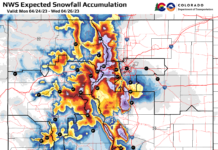Partners are preparing for another busy boating season at Green Mountain Reservoir which opens on May 18 for the summer season. Following last years’ confirmed presence of invasive quagga mussel larvae, known as veligers, in the reservoir, the Forest Service, Colorado Parks and Wildlife (CPW) and the Bureau of Reclamation (BOR) have taken proactive steps to continue to monitor and protect Green Mountain Reservoir. This year there will be a few changes to inspection locations in response to the veliger discovery.
Inspections and decontaminations for Green Mountain Reservoir will open May 18 at the Big Green Boat Ramp from 7:00 a.m. – 7:00 p.m. The boat ramps are closed when inspectors are not present and motorized boats are required to launch from an official inspection station site. Launching motorized boats from other ramps is prohibited and could result in a fine. The inspection station will move to the Heeney Marina ramp in mid-June as water levels and progress on marina improvements dictates.
McDonald Flats Boat Ramp is only open to hand-launched and hand-powered watercraft this year. The reservoir will close to motorized watercraft on Oct. 15, 2018 at 7:00 PM.
“We are asking the public to adhere to the inspection locations and times so we can protect the reservoir,” said Bill Jackson, District Ranger. “Get a head start by remembering to clean, drain, and dry your equipment before and after use.”
The Heeney Marina will not be open until mid-June due to planned improvements and construction for additional infrastructure and parking to accommodate the new inspection and containment protocols.
The inspection stations will continue to implement containment protocols put in place late last year which means that every boat has to be inspected when exiting the reservoir and will be issued a seal and blue receipt. If a boater leaving Green Mountain Reservoir intends to launch in a different water body, their boat must be decontaminated before launching by a certified professional. Cooperation with Colorado’s mandatory inspection and decontamination program has proven successful to stop the movement of harmful invasive species, such as quagga mussels, into new waters. Public awareness and participation is the best tool in the prevention of invasive species.
“We suspect the veligers in Green Mountain came from a boat that launched illegally,” said CPW’s Invasive Species Coordinator Elizabeth Brown. “That just shows how important a rigorous inspection program is to help protect all waters, and it shows how critical it is for the public to cooperate and help us protect the resource we all enjoy and need for drinking, irrigation, power generation and recreation.”
U.S. Bureau of Reclamation detected quagga mussel larva in Green Mountain Reservoir in fall of 2017. After detection, CPW immediately instituted rapid response which includes increased monitoring. CPW will continue monthly monitoring of the reservoir this season for all life stages of invasive mussels and other invasive species. Although additional larvae have not been found in subsequent sampling, officials are collaborating in an attempt to prevent Colorado’s first full blown infestation in state waters.
Because these invasive mussels infest waters by the billions, these mussels pose a massive financial, recreational, and ecological threat to Green Mountain Reservoir and other bodies of water throughout the state. They latch onto almost any surface, eventually encrusting lake bottoms, beaches, buoys, docks and other structures. They clog boat motors and plug water distribution systems critical for irrigation and energy production. In addition, they consume nutrients that native fish and other species need to survive.
For more information about how you can help protect Colorado’s bodies of water from invasive species visit Colorado Parks and Wildlife here:
https:// cpw.state.co.us/aboutus/Pages/ISP-ANS. aspx .








